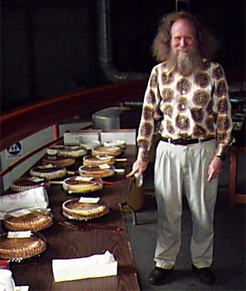
In schools throughout the United States, March 14 is Pi Day. Why? March is the third month, so if we express "March 14" as a decimal, we get 3.14, which is the approximation for the number pi we learned all those years ago. The purpose of Pi Day is simply to celebrate the important and mysterious number pi.
In the St. Bonaventure Department of Mathematics, Pi Day festivities begin precisely at 1:59 p.m. and end precisely 2 hours 65 minutes later. Like the date of Pi Day, these figures are derived from the digits of pi: to eight digits beyond the decimal point, pi is about 3.14 159 265. Our celebrations occur in and near De La Roche 301 and include pie (naturally), pi-ounce bags of m&m's (really), a pi recitation contest (naturally), a giant Pi Day display, and an opportunity to find your birthday in the digits of pi.
In the fall, the Department of Mathematics celebrates Integral Day on October 29.
On this page, you'll find more about Pi Day at SBU and more about the fascinating number pi.
Pi Background
Pi is defined to be the ratio between the circumference C of a circle and its diameter d. Thus, π = C/d. Implicit in this definition is a fact from geometry: in the Euclidean plane, the ratio of the circumference of a circle to its diameter is the same for every circle.
 Calculus has been used to prove that pi is irrational, which implies that the digits of pi go on forever without settling into a repeating pattern. Using powerful mathematics and powerful computers, pi has been computed to one hundred trillion digits (see Pi Facts, below). The digits of pi do not appear to have any pattern whatsoever---they seem to be random. It's remarkable that from such simplicity (π = C/d) comes such complexity (the digits of pi).
Calculus has been used to prove that pi is irrational, which implies that the digits of pi go on forever without settling into a repeating pattern. Using powerful mathematics and powerful computers, pi has been computed to one hundred trillion digits (see Pi Facts, below). The digits of pi do not appear to have any pattern whatsoever---they seem to be random. It's remarkable that from such simplicity (π = C/d) comes such complexity (the digits of pi).
The idea of "Pi Day" originated with physicist Larry Shaw, who organized the first Pi Day celebration at the San Francisco Exploratorium in 1988. Almost exactly twenty-one years later, on March 11, 2009, the U.S. House of Representatives passed a resolution proclaiming March 14 to be National Pi Day. The resolution encourages schools to teach their students about pi and to "engage them about mathematics." On behalf of the thousands and thousands of people who have enjoyed Pi Day and were, as a result, engaged about mathematics, thank you Mr. Shaw!
On this page, the following (common but not universal) convention is used: when counting digits of pi, the initial "3" is skipped. For example, pi to eight digits is 3.14159265.
Pi Sites
At the following pi-related web sites, you can learn more about pi, gaze at the digits of pi, search the digits of pi, listen to pi, match wits with pi, or buy cool stuff celebrating pi.
- Talking about Pi A celebration of and information about mathematics' greatest constant.
- http://3.141592653589793238462643383279502884197169399375105820974944592.com/index314159.html The URL of this website is as cool as its contents, which are the first one million digits of pi. The digits are helpfully arranged in rows of one hundred. The person who maintains this page changes its URL slightly (specifically, the "index" portion) from time to time to prevent excessive traffic from crashing his server. The above URL is accurate as of Pi Day 2019.
- The Pi-Search Page Search for any string of digits (up to 120 of them) in the first 200 million digits of pi. For example, you can search the digits of pi for your birthday. (If your birthday were, say, February 26, 1984, you would search for the string 022684 or the string 02261984.)
- Irrational Numbers Search Engine Search the first two billion digits of pi. Not as fast as the Pi Search Page, but it offers ten times the number of digits of pi. Additionally, the Irrational Numbers Search Engine allows you to search the first two billion digits of e, the first two billion digits of the square root of 2, and the first 500 million digits of the golden ratio phi.
- Singing Pi Once this page loads, it sings the digits of pi to you. Unlike pi itself, the song eventually repeats.
- Pi Trivia Game Part of Eve Andersson's Pi Land, this game tests your knowledge of pi.
- Cafe Press sells numerous pi-related tee-shirts, mugs, and other items. Just search the site for "pi" or "pi day."
Pi Songs
Happy Pi Day (By LaVern Christianson. Sung to the tune of “Happy Birthday.”)
Happy Pi Day to you,
Happy Pi Day to you,
Happy Pi Day everybody,
Happy Pi Day to you.
Oh Number Pi (By LaVern Christianson. Sung to the tune of “Oh Christmas Tree.”)
Oh, number pi
Oh, number pi
Your digits are unending,
Oh, number pi
Oh, number pi
No pattern are you sending.
You're three point one four one five nine,
And even more if we had time.
Oh, number pi
Oh, number pi
For circle lengths unbending.
Oh, number pi
Oh, number pi
You are a number very sweet,
Oh, number pi
Oh, number pi
Your uses are so very neat.
There's 2 pi r and pi r squared,
Four-thirds pi r cubed---don't be scared.
Oh, number pi
Oh, number pi
We know that pi's a tasty treat.
American Pi (All rights reserved, lyric © 1997--2007 Lawrence Mark Lesser. Sung to the tune of Don McClean's "American Pie."
Pi to 1000 digits
Each row contains 50 digits (ignoring the initial "3"). One curious feature of this segment of pi is the appearance of six consecutive nines, beginning at digit 762. The author Douglas Hofstadter once remarked that he'd like to memorize the digits of pi out to this spot so that he could recite them, concluding with "nine, nine, nine, nine, nine, nine, and so on," giving the impression that the digits continued to repeat.
3.14159265358979323846264338327950288419716939937510
58209749445923078164062862089986280348253421170679
82148086513282306647093844609550582231725359408128
48111745028410270193852110555964462294895493038196
44288109756659334461284756482337867831652712019091
45648566923460348610454326648213393607260249141273
72458700660631558817488152092096282925409171536436
78925903600113305305488204665213841469519415116094
33057270365759591953092186117381932611793105118548
07446237996274956735188575272489122793818301194912
98336733624406566430860213949463952247371907021798
60943702770539217176293176752384674818467669405132
00056812714526356082778577134275778960917363717872
14684409012249534301465495853710507922796892589235
42019956112129021960864034418159813629774771309960
51870721134999999837297804995105973173281609631859
50244594553469083026425223082533446850352619311881
71010003137838752886587533208381420617177669147303
59825349042875546873115956286388235378759375195778
18577805321712268066130019278766111959092164201989